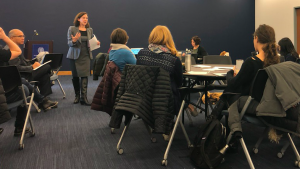I sit in a classroom at Georgetown when my professor inquires, “How many of your high school classmates are sitting in seats like these right now?” Reflecting on years in an established middle-class school system, I am optimistic about those peers being in university chairs, perhaps at in-state colleges. Peers from my early elementary education, on the other hand? I am more doubtful.
Growing up in a rural Idahoan town where agriculture ran the economy, the small population—my town being around 100 people; the actual “town” (i.e. that which is noted on a map) being less than 2,000—contained a high presence of poverty and inequality. Those who did well on their farms comprised the minute percentage of millionaires; other than that, the region was chronically low-income, the median income falling not far from the poverty line. Just as the schools in my area were the center of the community—interfacing students from wealthy farming families and those from migrant farm families—education has exposed the same inequalities in our nation as a whole.
Some days at an established, prestigious, East Coast institution such as Georgetown, I feel like I fit in with the stereotypical norm of the higher-education clientele. Coming from a solid two-parent household, I have had privileges land in my lap, such as birthright citizenship into this nation, the ease of a natively English-speaking household, and of course the ingrained white privilege. I accept those characteristics as a fact of where I come from, neither to flaunt nor to cry pity. But after reflecting on the income-disparate environments in which I have lived, I do not feel like the norm at Georgetown.
My rural elementary school was under Title I classification, meaning it receives federal funding because of the low-income status of its students and families. Academically, the goals of the school district (comprised of three schools: one elementary, one middle, and one high school) were proficiency and graduation, not necessarily college or opportunity. Raised in an education-centric home, in which reading came shortly after learning to walk and talk, my parents encouraged me by reading to and with me. By default I ended up at the top of my class, in gifted and talented programs and the like. Elsewhere in the town, there were too many homes without anything to read: no magazine on the table, no book on a shelf, no newspapers or flyers. The interlaced strands of literacy, education, generation, and income manifest in this discussion of income disparity and poverty. On this scale, I transcended the low-income association: my parents were literate, had attended college, and worn books decorated our shelves and coffee tables. Nevertheless, I was not exempt from the associations of low-income. Yes, I was among the 65-80% who received free or reduced lunch at school. I remember when the free breakfast program was implemented, primarily to offer the necessity of a meal to those who came hungry.
In a study group the night following the professor’s question, we reflected on her intention. I clearly no longer fit the privilege I thought I had. I learned that many came from affluent, suburban communities of Massachusetts, New Jersey, and Maryland, which seemed so different from my life back at home. Quality education appeared to be a given in their circumstances, a norm that my rural hometown severely lacked. They told me they attended prep schools or private schools and seemed bewildered as to why our professor would ask such a question. My own bewilderment struck me, not toward the professor’s inquiry, but toward my own naïveté of the continual presence of inequality. Flashing back to days at a Title I school reverberated in my mind, to days receiving lunch at school, not even knowing I was getting it through a federal subsidy. I noticed how the cycle continues—my elementary classmates are certainly not sitting in a college classroom right now, not because they were lazy, or lacked ambition, but because of structural inequalities that predetermine their future. When the cost to attend my university is over double the median income of my small town, pure numbers create obstacles for those trying to achieve the American Dream.




